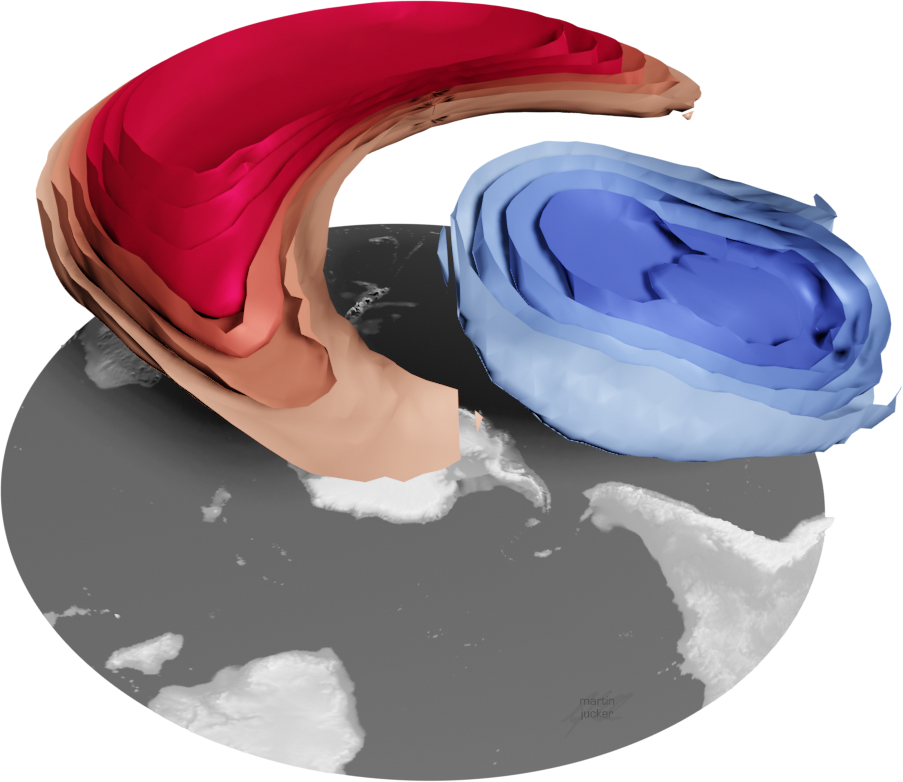Picture: “Satellite image of January 1, 2020, showing a brown plume of smoke from Australian bushfires. The smoke was transported across the entire globe and caused serious health issues for the entire Australian East Coast. Credit: Image from Himawari 8, 2020–01–01 12:00 EAST, https://himawari8.nict.go.jp.
The end of 2019 saw Eastern Australia swallowed by bushfire smoke. One contributor to the bushfire season was a rare and extreme weather event. We found out exactly how rare it was and how rare it will be into the future.
The spring of 2019 was exceptional for Eastern Australia: Scorching heat, the culmination of a three-year drought, and bushfires raging much earlier in the season than any other time in recorded history. By summer, the burning and related loss of flora, fauna, and human lives, as well as respiratory health impacts, were at a disastrous scale. While the reasons for this devastating natural catastrophe were many – and still are subject to intensive research – a recent paper shows how rare one of the main contributors to that extreme fire weather was, and how in a future warmer world it will become even rarer to the point of being almost impossible.
Interestingly, the usual suspect for fire weather, the El Niño Southern Oscillation (or ENSO) wasn’t doing much that year. But there were other obvious factors like a multi-year drought and a strong Indian Ocean Dipole (IOD) that played a role. But in 2019 there was a third factor: a strongly negative Southern Annular Mode (SAM), which is known to be related to hot and dry conditions over Eastern Australia. The SAM can be driven by many different things, but in 2019 the obvious driver was a very rare one indeed.

In the spring of 2019, the usually very strong winds in the stratosphere (about 300km/h at a height of 30km) almost completely collapsed within a matter of days – a so-called Sudden Stratospheric Warming was underway. These events high in the atmosphere are known to influence the wind structure at the surface and cause fire-prone conditions at the ground. That’s why in early September, the stratospheric research community argued that something very rare was happening and might make things much worse.
Unfortunately, the researchers were right.
A Sudden Stratospheric Warming has only been recorded once before in the Southern Hemisphere, in the spring of 2002 (which was also followed by fires that summer). What we know from climate models is that events like these are usually followed by hot and dry conditions in Australia, and that these conditions prevail for many months (eg into the summer).
But because this had only happened for the second time on record, it was impossible to say how rare this event was and, crucially, we didn’t know if this frequency would alter with climate change. Was this second event after 2002 a result of climate change? Does this mean we should expect more of those to happen given we are still happily pumping greenhouse gases into the atmosphere? The only reliable measurements of the stratosphere come from satellites, and they have only been around since the end of the 1970s. Before that, balloon measurements give us some indication that nothing similar has happened since the 1950s. Before that, we have no idea.
Running climate models which include a good representation of the stratosphere is very expensive, but people didn’t think it was important to run these investigations – at least compared to what the oceans and other things do to local climate and weather. As a result, those climate model simulations we did have of this part of the atmosphere were usually not reliable or simply too short.
This is why we spent a long time running a very good climate model for a very long time – 9,900 years to be precise (the simulated time, not the time it took us to run it). With this simulation we were able to determine how many times events like 2019 would have happened. We found they would have occurred about once every 22 years under conditions similar to the year 1990. That aligns well with the 17 years between the sudden stratospheric events in 2002 and 2019. However, we also found that in the future (a world similar to 2080), due to greenhouse gas emissions, these events tend to decline rapidly, happening about once every 300 years.
We are already a third of the way to 2080 (since 1990), so these stratospheric events already happen less frequently than once every 22 years. So, what will the world look like in 300 years if that is the next time a sudden stratospheric warming event occurs? Probably nothing like 2021 (remember the year 1721?), but the chances are that until another such event happens in the Southern Hemisphere, we will have to deal with lots of other catastrophic events related to climate change. In the balance of things, perhaps having a few more sudden stratospheric warming events and learning how to deal with them would be better than dealing with the consequences of climate change. But make no mistake, the stratosphere still influences our weather, whether there are Sudden Stratospheric Warmings or not.
Paper: Jucker, M., Reichler, T., & Waugh, D. W. (2021). How frequent are Antarctic sudden stratospheric warmings in present and future climate?. Geophysical Research Letters, 48, e2021GL093215. https://doi.org/10.1029/2021GL093215
